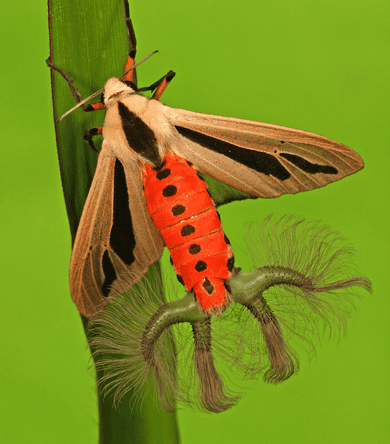Baphomet moth has captured the attention of many due to its unique appearance and behavior. This species had gone viral on the Internet for a while. What’s so special about these insects? Let’s explore fascinating facts about this moth to find out!
Phylum: Arthropoda
Class: Insecta
Order: Lepidoptera
Family: Erebidae
Subfamily: Arctiinae
Genus: Creatonotos
1. Baphomet moths have hairy tentacles
The Baphomet moth, also known as the Australian horror moth, is one of the weirdest moths in the world. Despite its remarkable appearance, the moth is a relatively small moth, with an average wingspan of about 1.6 inches (4 cm).
Both male and female moths have brown forewings adorned with dark streaks. Their hindwings are white. When the wings are closed, this pattern remains partially viewable. The wingspan of this species measures around 1.6 inches (4 cm). Their abdomen is red, occasionally yellow, with a broken black stripe in the middle. The abdomen is usually bright red, although yellow is also observed.

What sets these Baphomet moths apart from other tiger moth types is their extensible hairy tentacles on the tip of their abdomen. These tentacles can even extend longer than their body itself when fully extended. This feature makes them look like aliens, however, they are not dangerous at all.
These tentacles are scent organs, also called coremata or hair-pencils. They are responsible for producing the pheromone hydroxydanaidal which has 2 functions: attracting and deterring.

When males wish to attract females, they will emit chemicals working as an aphrodisiac as well as a tranquilizer. However, when other Creatonotos gangis males catch a whiff, the chemicals work as a useful deterrent, caring the rivals away.
To spread pheromones, these creatures will push their hair-pencils out of their abdomen by using ‘sclerotised’ levers produced from the hardened cuticle. All Lepidopteran males have this coremata part. However, their hair-pencils are not exposed like that of Baphomet moth.
2. Habitat and distribution
The Baphomet moth lives in Southeast Asia, such as Japan, Iran, Sri Lanka, India, Thailand, Indonesia, and China, as well as parts of Australia like Mackay, New Guinea, Queensland, and Northern Territory. While it is found in both regions, the species is more common in Asia.

What sets this tiger moth type apart from their counterparts is their adaptability. These moths can be found in a variety of habitats. Nonetheless, the insect favors areas where fruit trees are abundant, particularly pomegranate trees.
3. They eat toxic leaves
Baphomet moths mainly feed on nectar from host plants such as sweet potato, lucerne crops, groundnuts, coffee, ragi, Pennisetum americanum, sorghum, and rice. Their larvae have an insatiable appetite and consume a variety of plant species, including pomegranate leaves (favorite), sweet potatoes, rice, and sorghum foliage.
These caterpillars have a preference for plants that contain high levels of pyrrolizidine alkaloids (PAs), a bitter and poisonous chemical. Normally, when plants are damaged, they produce a huge amount of PAs as a defense mechanism to prevent insects and animals from eating the leaves.

However, Baphomet moth caterpillars have evolved to enjoy the taste of PAs. The males eat PAs throughout the larvae stage to manufacture their pheromones. The more PAs they consume, the bigger their coremata.
Even as adults, they will continue to consume PAs to maintain their coremata. If they don’t acquire enough chemicals, their coremata won’t grow big enough to function.
These insects are eaten by predators like bats and birds.
4. Life cycle
During the mating season, the males will release their pheromones to woo females. The male with massive coremata can lure females from great distances. If a female is interested, she will signal her receptiveness by flicking her antennae and stretching her abdomen to mate.

Once mated, the female Baphomet moth will lay clusters of up to 50 round, yellow eggs in rows on the underside of host plant leaves. The egg hatch and the larvae emerge. Their hairy body is brown with yellow bands on the back.

After feeding and growing, the caterpillars will pupate on dead leaves and enclose themselves in a sparse cocoon made from larval hairs. Eventually, adult moths emerge and they only live for 5 – 7 days.
References:

